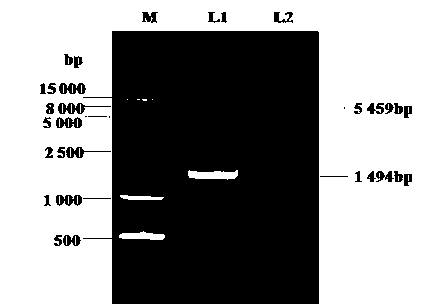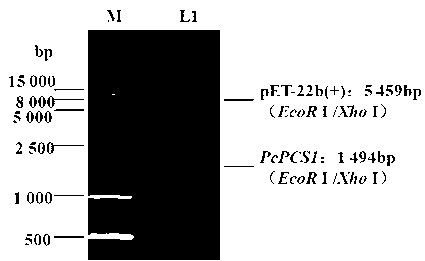Escherichia coli engineering bacteria and preparation method and applications thereof
A technology of Escherichia coli and engineering bacteria, applied in the fields of botanical equipment and methods, biochemical equipment and methods, applications, etc., can solve the problems of unclear, no literature reports, etc.
- Summary
- Abstract
- Description
- Claims
- Application Information
AI Technical Summary
Problems solved by technology
Method used
Image
Examples
Embodiment 1
[0026] Embodiment 1 bean pear PcPCS1 Construction of gene expression vector in Escherichia coli
[0027] bean pear PcPCS1 The construction process of gene Escherichia coli expression vector PcPCS1-pET-22b (+) is as follows figure 1 .
[0028] Pear phytochelatin synthase gene with registration number KC936270 in GenBank PcPCS1 , its coding region nucleotide sequence is SEQ ID NO.1:
[0029] ATGGCGATGG CGGGGTTGTA TCGGCGCCTT CTTCCTTCAC CCCCTGCCGT CGATTTCGCT 60
[0030] TCCTCTCAGG GCAAGCAACT TTTTCTTGAA GCGGTTCAAA ATGGAACCAT GGAAAGCTTT 120
[0031] TACAGGTTGG TTTCATATTT CCAAACGCAA TCAGAGCCTG CATTTTGTGG CCTCGCGAGC 180
[0032] TTGTCCATGG TCCTCAATGC TCTTGCCATT GATCCTGGCA GAAAATGGAA AGGGCCTTGG 240
[0033] AGATGGTTTG ATGAATCTAT GTTAGACTGT TGCGAGCCTT TGGAGACTGT CAAAGTAAGA 300
[0034] GGCATCTCAT TTGGGAAGCT TGTCTGCTTG GCTCACTGTG CTGGAGCAAA AGTTGAAGCC 360
[0035] TTTCGCACAA ATCATAGCAC AATTGATGAG TTTCGTAAAT ATGTATTGAG ATGTTCTACT 420
[0036] TCTGATGATT GTCATGTGAT CTCATCATA...
Embodiment 2
[0071] Embodiment 2 bean pear PcPCS1 Obtaining and Identification of Recombinant Escherichia coli Cells
[0072] Escherichia coli Rosetta (DE3) ( Escherichia coli ) (purchased from Merck, Germany, the company website is http: / / www.emdmillipore.com), graded and streaked on the LB plate medium, and put the streaked plate medium upside down in a constant temperature incubator at 37 °C overnight nourish. Pick a single colony, inoculate it in LB liquid medium, shake it at 150 rpm at 37 °C until OD 600 =0.6, put the cell culture solution in ice to stop the cultivation. Take 1 mL of the above bacteria culture solution in a 1.5 mL centrifuge tube, place on ice for 10 minutes, centrifuge at 10 000 rpm at 4°C for 10 minutes, and discard the supernatant. Add 200 μL of ice-cold 50 mmol / L CaCl 2 The solution was used to gently suspend the cells, placed on ice for 15 minutes, and then centrifuged at 10 000 rpm at 4°C for 10 minutes. Discard the supernatant, add 100 μL of pre-coo...
Embodiment 3
[0075] Example 3 Recombinant Escherichia coli PcPCS1-pET-22b (+) / Rosetta (DE3) to Cd 2+ 、Cu 2+ and Na + determination of tolerance
[0076] The recombinant Escherichia coli strain PcPCS1-pET-22b(+) / Rosetta (DE3) was cultured on LB liquid medium containing 100 mg / L ampicillin to OD 600 = 0.5, while Escherichia coli strain Rosetta (DE3) was used as a control, cultured on LB liquid medium to OD 600 = 0.5. After 10-fold serial dilution of the two bacterial solutions, 5 μL samples were taken and added with different concentrations of CdCl 2 2.5H 2 O, CuCl 2 2H 2 Incubate on LB solid medium with O or NaCl for 16 h at 37°C, observe the growth of the colonies and take pictures.
[0077] Figure 7 A shows: recombinant Escherichia coli strain PcPCS1-pET-22b (+) / Rosetta (DE3) and non-recombinant Rosetta (DE3) bacterial liquid 600 All 0.5) after dilution 1, 10, 100 and 1000 times, the growth on blank LB solid medium was the same.
[0078] Figure 7 B shows: the...
PUM
 Login to View More
Login to View More Abstract
Description
Claims
Application Information
 Login to View More
Login to View More - R&D
- Intellectual Property
- Life Sciences
- Materials
- Tech Scout
- Unparalleled Data Quality
- Higher Quality Content
- 60% Fewer Hallucinations
Browse by: Latest US Patents, China's latest patents, Technical Efficacy Thesaurus, Application Domain, Technology Topic, Popular Technical Reports.
© 2025 PatSnap. All rights reserved.Legal|Privacy policy|Modern Slavery Act Transparency Statement|Sitemap|About US| Contact US: help@patsnap.com



